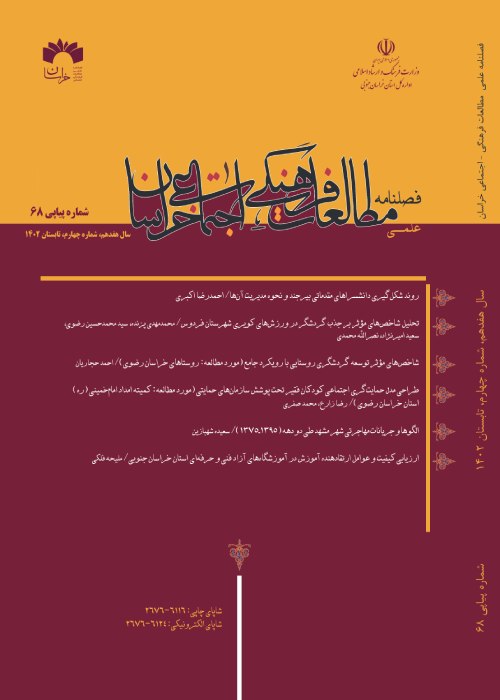Ranking the Capacities for Creating Economic Prosperity in Region 9 of Land Use Planning
Author(s):
Article Type:
Research/Original Article (دارای رتبه معتبر)
Abstract:
Introduction
Assessing the capacity to foster economic prosperity is a critical and constructive factor for planning and implementing any government’s long-term strategies within a region or society. Without an accurate evaluation of economic prosperity, governments and economic policymakers may encounter epistemological challenges within their economic communities. Therefore, a comprehensive understanding of a region’s economic prosperity is essential for policy planning. Regions and villages serve as the primary levels of management and are the main implementers of government policies. In today’s world, the regional economy plays a significant role in management and development planning. The regional economy comprises various sectors, each possessing different capacities and capabilities. For regional development and national development planning, it is imperative not to make assumptions about investment, production, and employment being constant across all sectors. Optimal allocation of production facilities and resources requires consideration of regional potentials and capabilities in the production of goods and services in all national development plans. This approach can potentially increase the share of economic sectors in national production. Therefore, identifying drivers to create economic prosperity in the 9th region of land use planning is considered an important strategy for implementing economic development growth policies. Given the importance of this subject, this research aims to measure the capacity for creating economic prosperity in the 9th district using a multi-criteria decision-making method. The research seeks to assess which cities have a higher capacity and potential for creating economic prosperity in the 9th region. It also aims to determine the importance coefficient of different economic sectors from experts’ perspectives. The results indicate that agriculture, mining, services, and industry are highly significant in the region for economic prosperity.Methods
The main objective of this study is to identify the drivers of economic prosperity among large cities (region 9 of land use planning) based on a multi-criteria decision-making model. This study is applied in terms of its objectives. The data collection methodology is based on library and documentary data, as well as questionnaires. The output from these questionnaires has been processed using Expert Choice software. The research approach is descriptive-analytical. The data used in this research are obtained from the Statistical Center of Iran. The study’s statistical population encompasses nine regions (South, North, and Razavi) and 52 counties within these regions. The research aims to rank these nine regions and 52 counties using the TOPSIS model and hierarchical analysis. The methodology for implementing this ranking process is detailed in the following sections.Findings
The findings from the TOPSIS (AHP) model, based on the insights of twelve experts in the field of economic sciences and planning, indicate that the agriculture index, with a weight of 0.421, is ranked first. This is followed by the mining index with a weight of 0.277 in second place, and the service index with a weight of 0.157 in third place. The industry index, with a weight of 0.145, is positioned last. When excluding the added value of oil and gas, the cities are ranked as follows: Mashhad leads with a score of 0.593, followed by Khaf with a score of 0.463, and Zirkuh with a score of 0.414, placing them in first, second, and third places respectively. Conversely, the cities of Salehabad (score: 0.014), Sheshtamad (score: 0.002), and Kuhsorkh (score: 0.001) are ranked at the bottom.Conclusion
This study aims to rank the potential for economic prosperity in the ninth region of Iran’s land use planning. The ranking is based on a multi-criteria decision-making model, utilizing four sub-economic indices from the country’s national accounts in 2020. These economic sub-indices are categorized into four sectors: agriculture, industry, mining, and services. The Analytic Hierarchy Process (AHP) model was employed to weight these indices and determine their significance. Through pairwise comparison of the four indices and assigning weights based on expert opinions, it was determined that the agriculture sector received the highest weight of 0.421, followed by mining with a weight of 0.277. The service sector was assigned a lower weight of 0.157, while the industry sector received the lowest weight of 0.145.Keywords:
Language:
Persian
Published:
Scientific Quarterly of Social-Cultural Studies of Khorasan, Volume:17 Issue: 3, 2023
Pages:
119 to 152
magiran.com/p2636258
دانلود و مطالعه متن این مقاله با یکی از روشهای زیر امکان پذیر است:
اشتراک شخصی
با عضویت و پرداخت آنلاین حق اشتراک یکساله به مبلغ 1,390,000ريال میتوانید 70 عنوان مطلب دانلود کنید!
اشتراک سازمانی
به کتابخانه دانشگاه یا محل کار خود پیشنهاد کنید تا اشتراک سازمانی این پایگاه را برای دسترسی نامحدود همه کاربران به متن مطالب تهیه نمایند!
توجه!
- حق عضویت دریافتی صرف حمایت از نشریات عضو و نگهداری، تکمیل و توسعه مگیران میشود.
- پرداخت حق اشتراک و دانلود مقالات اجازه بازنشر آن در سایر رسانههای چاپی و دیجیتال را به کاربر نمیدهد.
In order to view content subscription is required
Personal subscription
Subscribe magiran.com for 70 € euros via PayPal and download 70 articles during a year.
Organization subscription
Please contact us to subscribe your university or library for unlimited access!


